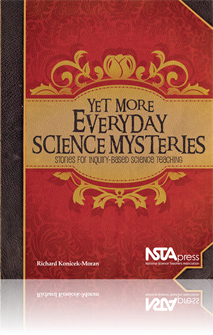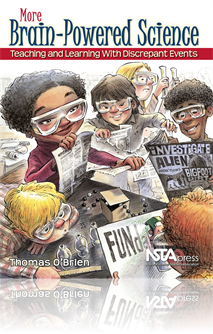All Book Chapters
Book Chapter
Lichens are everywhere, yet most people fail to notice them because they are so familiar. The story in this chapter was written to help persuade teachers to acquaint their students with these unique forms of life. Many biology teachers tend to gloss ...
Book Chapter
Comeback Cans: Potentially Energize “You CAN Do” Science Attitudes
Learners predict-observe-explain the rolling behavior of the two cans in terms of kinetic and potential energy conversions and friction. Two seemingly identical opaque cans are set against each other in a race on a flat surface. Initially, both can...
Book Chapter
Follow That Star: <i>National Science Education Standards</i> and True North
Earth’s magnetic field and its effect on compasses can help people find their bearings relative to a fixed target or direction. In this activity, many learners will have difficulty locating their compass bearings if they are inside a room (especi...
Book Chapter
“Horsing Around”: Curriculum-Instruction-Assessment Problems
The nature of science (NOS) involves actively seeking (rather than avoiding) challenging problems that may require looking at situations differently and thinking outside of artificially imposed constraints. Science, like art, is a creative endeavo...
Book Chapter
Magical Signs of Science: “Basic Indicators” for Student Inquiry
Advertisements capture consumers’ attention and motivate them to buy certain products. Similarly, teachers need to sell science to students by walking the talk of research-informed best practices. Magic signs with (dis)appearing messages (or col...
Book Chapter
Verifying Vexing Volumes: “Can Be as Easy as Pi” Mathematics
Mathematics is both a key to unlocking the secrets of nature and, for many students, a stumbling block to conceptual understanding in science. In this activity, two sheets of 8.5 in. × 11 in. paper are used to construct two cylinders with surprising...
Book Chapter
Bottle Band Basics: A Pitch for Sound Science
In this activity, three identical-size glass soft drink bottles with varying amounts of water are used to make sounds of various pitches. Upon initial consideration, the pattern established when using the bottles as wind instruments seems to suggest ...
Book Chapter
Metric Measurements, Magnitudes, and Mathematics: Connections Matter in Science
This model-building activity helps learners visualize SI’s base-ten relationships; the connections between the meter, liter, and gram; the real-world relevance of mathematics to science; and the somewhat abstract concept of powers of ten that is so...
Book Chapter
Cookie Mining: A Food-for-Thought Simulation
In this activity, various brands, sizes, and textures of chocolate chip cookies are “mined” as an edible analogy for natural resource management and conservation....
Book Chapter
Teachers (or students) are asked to generate and discuss a list of the Top 10 Crazy Ideas in Science and a related list of Top 10 Challenges of Learning Science. This brainstorming activity focuses on science as a school subject that can be mindless...
Book Chapter
In this activity, the wording and validity of the scientific and economic claims for compact fluorescent lightbulbs (CFLs) are critically examined. Their environmental impact relative to standard incandescent lightbulbs is also discussed....
Book Chapter
A Terrible Test That Teaches: Curriculum-Embedded Assessment
In this activity, a “terrible test” appears to be impossible to pass. However, it is intentionally designed to include common errors in item construction that, if noticed, allow the test-wise learner to ace the test without any prior knowledge of...
Book Chapter
Diagnostic Assessment: Discrepant Event or Essential Educational Experiment?
In this activity, learners are asked to complete sample diagnostic assessments that model how nongraded, preinstructional “tests” support learner-centered curriculum and instruction. These kinds of tests, the specific questions asked, and the mis...
Book Chapter
Dual-Density Discrepancies: Ice Is Nice and Sugar Is Sweet
Seemingly identical crystalline cubes (ice versus halite crystals) are observed to either sink or float in two seemingly identical clear, colorless liquids (ethanol and water). Also, a handful of sugar cubes are observed to sink in a container of ...
Book Chapter
Inferences, Inquiry, and Insight: Meaningful “Miss-takes”
The Nature of Science (NOS) includes making scientific inferences based on available empirical evidence (observation) and logical arguments (e.g., prediction based on pattern recognition). Making and learning from “miss-takes” uncovered via sk...



